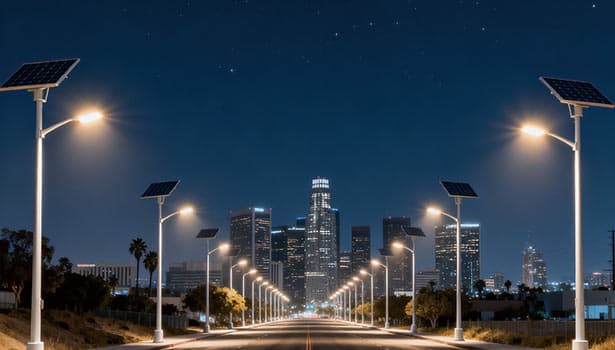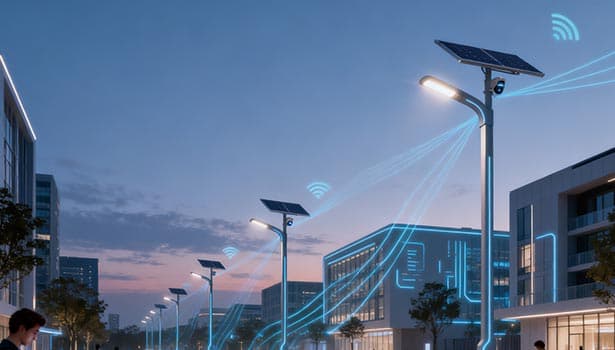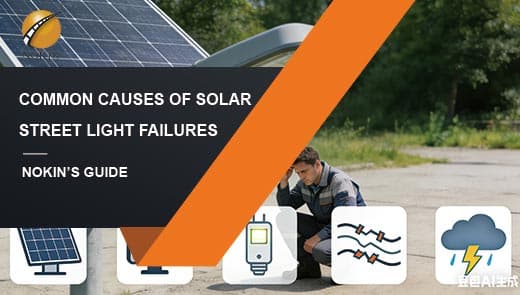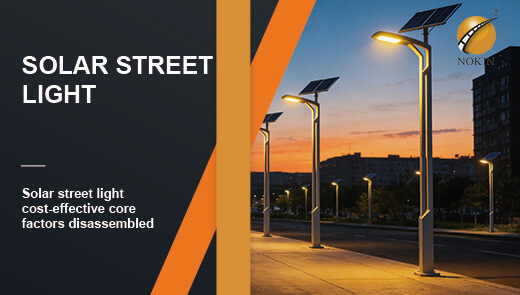Benefits of Solar Street Lights for Urban Areas
In the process of global urbanization, urban lighting infrastructure is generally confronted with three core predicaments: First, high energy consumption and financial pressure. Traditional street lights rely on power supply from the power grid. The average annual electricity cost for street lights in American cities exceeds 10 million US dollars per city, and in some major European cities, the lighting cost accounts for 8% to 12% of the municipal budget. The second is the carbon emission burden. About 70% of the electricity for traditional street lights comes from fossil fuel power generation. A single 100W street light emits an average of 0.3 tons of carbon annually, intensifying the pressure on global climate governance. The third issue is the gap in lighting coverage. In remote suburbs of developing countries and newly built communities in developed countries, due to the lagging power grid, about 35% of the roads have no night lighting, and the accident rate is four times higher than that in areas with complete lighting.
Solar street lights achieve completely independent operation from the power grid through core technologies such as photovoltaic panel photoelectric conversion, battery energy storage, and intelligent controller regulation. Its zero-carbon emissions and flexible installation features not only precisely match the emission reduction targets of the Paris Agreement but also have become a key driver for cities like New York and Sydney to promote smart city construction.

Solar Street Lights Can Relieve the Financial Burden on Cities
Solar LED street lights create continuous value for municipal finance through cost optimization throughout their entire life cycle. Their economic advantages are mainly reflected in three major links: energy consumption, installation and construction, and maintenance management.
Reduce Energy Costs
The continuous electricity bill for traditional street lights is a long-term source of pressure for municipal finances. Taking a 5-kilometer walkway in a medium-sized city in the United States as an example, 50 traditional 100W street lights are installed. With an average electricity price of 0.15 US dollars per kilowatt-hour and an average daily lighting time of 10 hours, each light consumes an average of 365 kilowatt-hours per year, resulting in an annual electricity bill of 27,375 US dollars.
After the adoption of solar street lights, the walkway achieved zero electricity charges, directly saving $27,375 in fiscal expenses annually. A larger-scale practice originated from Los Angeles. After replacing 8,000 solar street lights in 2023, the average annual electricity bill dropped from 4.2 million US dollars to 120,000 US dollars, a reduction of over 97%. All the saved funds were invested in public education projects.
Reduce Installation Costs
The installation of traditional street lights involves three major procedures: trenching and wiring, cable laying, and grid connection. The cost per kilometer can be as high as 30,000 to 40,000 US dollars, and the construction period lasts for 4 to 6 weeks. When installing solar street lights in high-density urban areas of Los Angeles, by optimizing the layout of light posts and integrating them with existing facilities, the cable trench excavation step was eliminated, reducing the cost per kilometer to $18,000, saving 35% compared to the traditional solution.
The new residential area project in Maranbigy, Australia, is more representative: 39 solar street lights will be installed on 15 kilometers of roads in 2024, and the entire construction will be completed in just 14 days. In contrast, if the traditional plan is adopted, it would take about three months to wait for the power grid to be laid, extending the installation period by six times and avoiding the interference of construction on residents' move-in.
High Return on Investment
The initial purchase price of a single solar street light is approximately $2,000 to $3,500, which is higher than that of traditional street lights ($800 to $1,500), but it has a significant cost advantage throughout its life cycle. A comparative study by the University of London shows that in the total cost of a single kilometer of road (20 street lights) over 10 years:
Traditional street lights: Initial purchase $16,000 + 10-year electricity bill $54,750 + maintenance $40,000 = $110,750
Solar street lights: Initial purchase of 50,000 US dollars + 0 electricity charges + maintenance of 8,000 US dollars = 58,000 US dollars
Compared with the two, solar street lights save $52,750 in cost over 10 years, with a return on investment of 91%, and their 25-year design life far exceeds that of traditional street lights (8-10 years).
Solar Street Lights Environmental Advantages
Under the global "carbon neutrality" trend, solar street lights have become an efficient path for cities to reduce emissions, and their environmental value is reflected in two major dimensions: carbon reduction and clean energy substitution.
Reduce Carbon Emissions
Thermal power accounts for 63% of the global electricity supply, and each kilowatt-hour of electricity corresponds to 0.8 kilograms of carbon dioxide emissions. The average annual carbon emission of a single 100W traditional street light is about 0.3 tons. In a city with a population of one million, the average annual carbon emission of 20,000 street lights can reach 6,000 tons, equivalent to the annual emissions of 1,300 family cars.
The zero-carbon feature of solar street lights has brought about significant emission reduction effects: The 10,000 solar street lights installed in the "Connected City" of Florida, USA, have reduced carbon emissions by an average of 3,000 tons annually, equivalent to the ecological benefits of planting 81,000 trees. According to data from the European Photovoltaic Industry Association, by 2024, EU cities have cumulatively reduced carbon emissions by over 1.2 million tons through solar street lights, accounting for 28% of the total carbon reduction in the lighting sector.
Application of Clean Energy
Sulfur dioxide and nitrogen oxides produced by traditional thermal power combustion are the main causes of urban smog. For every ton of standard coal burned, 6 to 8 kilograms of sulfur dioxide can be released. Solar street lights reduce pollutant emissions from the source by replacing clean energy.
The practices in rural areas of India are of considerable reference value: After installing 5,000 solar street lights in Rajasthan in 2023, the local demand for thermal power decreased by 1.825 million kilowatt-hours, corresponding to a reduction of 1,095 kilograms in sulfur dioxide emissions. The regional PM2.5 concentration dropped by 4.2 micrograms per cubic meter, and the rate of residents seeking medical treatment for respiratory diseases decreased by 7%. This emission reduction model has been incorporated into the air quality improvement action plans of cities such as Berlin and Toronto.

Solar Street Lights Enhance Urban Public Safety
Adequate and stable lighting is the fundamental guarantee for public safety. Through technological upgrades, solar street lights have achieved multi-dimensional improvements in visibility, crime prevention and emergency response.
Improve Visibility
Traditional high-pressure sodium lights have the drawbacks of uneven illumination and a 30% light attenuation within three years, which leads to blind spots in lighting when the distance between light poles exceeds 30 meters. The LED light source equipped on solar street lights has a uniform illumination of 0.7 (while traditional sodium lights only have 0.4). Even when the light poles are spaced 40 meters apart, there is no obvious shadow, and the brightness attenuation does not exceed 10% within five years.
The main road renovation project in El Paso, Texas, USA, shows that after installing solar street lights, the visibility on the road at night has increased from 18 meters to 35 meters. The average annual number of night traffic accidents on this section has dropped from 21 to 8, a reduction of 62%. Among them, the proportion of accidents caused by "poor visibility" has decreased from 82% to 18%.
Crime Prevention
Criminological research has confirmed that the incidence of theft and robbery cases in areas with insufficient lighting is 3.2 times that in areas with complete lighting. The 2024 report of the US Department of Justice shows that improved lighting conditions can reduce the crime rate at night in cities by 25% to 30%.
The practice in El Paso has confirmed this conclusion: After installing 200 solar street lights in the once high-incidence old communities, the coverage rate of night lighting increased from 28% to 92%, and the number of thefts in 2023 dropped from an average of 47 per year to 9, a decrease of 81%. What is more worth noting is that the solar street lights in Maranbridge County, Australia, are equipped with human body sensing functions, which can automatically adjust the brightness according to pedestrians and vehicles. This not only avoids energy waste but also ensures the lighting intensity during critical periods.
Facilitate Emergency Services
The independent power supply feature of solar street lights highlights its advantages in emergency scenarios. During Hurricane Ian's hit in Florida, USA in 2023, 10,000 solar street lights remained lit after the power grid broke down, creating a "visual channel" for rescue vehicles. This reduced the night emergency response time from 22 minutes to 14 minutes and saved at least 12 lives of critically ill patients.
Similar cases also exist in Europe: During the power grid failure in Copenhagen in 2024, the smart solar street lights in the city center automatically switched to emergency mode, guiding ambulances to the accident site quickly through high-frequency flashing, saving 40% of the response time compared to traditional lighting conditions.
Benefits of Solar Street Lights for Urban Operation and Infrastructure
Solar powered street lights have transcended their simple lighting function and become the core node of urban infrastructure upgrades, creating multiple values in terms of installation flexibility, maintenance costs, and intelligent integration.
Easy and Flexible Installation
The lagging power grid in newly-built areas and remote regions is a common problem faced by cities around the world. The feature of solar street lights that they do not require power grid support makes them an ideal choice for such areas. The New Zealand rural road project shows that installing solar street lights in areas without grid coverage reduces costs by 60% compared to traditional grid extension solutions, and the installation period is shortened from six months to one month.
The innovative practice in Malan Biji County is more exemplary: The county bypassed traditional power companies and directly installed off-grid solar street lights in newly built residential areas. This not only avoided the high cost of grid connection but also achieved the simultaneous delivery of lighting facilities and residential construction, increasing the occupancy rate of residents by 23%.
Low Maintenance Cost
The average annual cost of maintenance work such as circuit inspection and light source replacement for traditional street lights is 500 to 800 US dollars per light. However, solar street lights, with no complex circuits and longer core component lifespans, have an average annual maintenance cost of only 100 to 150 US dollars per light, a reduction of over 70%.
Integration of Smart Cities
Intelligent solar street lights have become important perception nodes in smart cities. In Singapore's "Smart Nation" project, street lights integrate three major functions: Wi-Fi hotspots, environmental sensors and security cameras.
- Public services: Free Wi-Fi covering 80% of the park area, with an average daily connection volume of over 5,000 people;
- Environmental monitoring: Upload temperature, humidity and PM2.5 data every 15 minutes to provide support for haze early warning;
- Safety control: In collaboration with the police system, the response time for abnormal behavior warnings has been shortened from 15 minutes to 4 minutes.
After the implementation of this project, the number of public security incidents in the park decreased by 42%, and the efficiency of environmental governance decision-making increased by 35%, fully demonstrating the platform-based value of solar street lights.

The Practical Path for Promoting the Implementation of Solar Street Lights
Pilot Promotion in Different Regions to Reduce Implementation Risks
Pilot projects will be prioritized in three types of areas: First, newly established development zones (such as the "Connected City" in Florida, USA) to quickly meet lighting demands; The second is remote areas without power grids (such as rural areas in New Zealand), to avoid the cost of power grid extension. The third is old communities (such as the city of El Paso), where the safety environment is improved through lighting upgrades. The pilot period is recommended to be 8 to 12 months, with a focus on tracking cost recovery and equipment stability data.
Select Suitable Products in Combination with Regional Characteristics
For different climatic conditions, precise selection should be made: In tropical rainy regions (such as Singapore), PERC photovoltaic panels with a conversion efficiency of over 23% should be chosen. In foggy areas (such as London), high-penetration solar LED street light sources with a color temperature of 5000K are adopted. In cold regions (such as Copenhagen), low-temperature batteries that can operate normally at -40 ℃ are configured to ensure stable operation throughout the year.
Rely on Professional Resources to Ensure the Quality of Implementation
Give priority to choosing brands with certification qualifications, as quality and after-sales service are more guaranteed. During the construction phase, a professional team is entrusted to establish acceptance standards, with a focus on verifying key parameters such as the inclination Angle of photovoltaic panels and the capacity of batteries.




